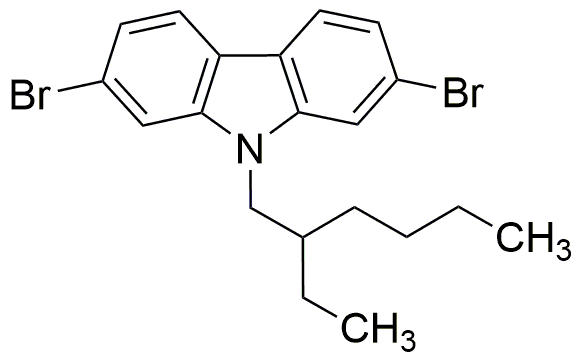2,7-Dibromo-9-(2-ethylhexyl)carbazole is widely utilized in research focused on:
- Organic Photovoltaics: This compound is used as a material in organic solar cells, enhancing their efficiency and stability. Its unique structure allows for better light absorption and charge transport.
- Light-Emitting Diodes (LEDs): It serves as a key component in the development of high-performance LEDs, contributing to improved brightness and energy efficiency in various lighting applications.
- Fluorescent Sensors: The compound is employed in creating fluorescent sensors for detecting environmental pollutants, providing a sensitive and reliable method for monitoring air and water quality.
- Polymer Additives: Used as an additive in polymer formulations, it enhances thermal stability and mechanical properties, making it valuable in the production of durable materials for automotive and construction industries.
- Research in Photonic Devices: It is explored in the development of advanced photonic devices, offering potential applications in telecommunications and data processing due to its favorable optical properties.
Informations générales
Propriétés
Sécurité et réglementation
Applications
2,7-Dibromo-9-(2-ethylhexyl)carbazole is widely utilized in research focused on:
- Organic Photovoltaics: This compound is used as a material in organic solar cells, enhancing their efficiency and stability. Its unique structure allows for better light absorption and charge transport.
- Light-Emitting Diodes (LEDs): It serves as a key component in the development of high-performance LEDs, contributing to improved brightness and energy efficiency in various lighting applications.
- Fluorescent Sensors: The compound is employed in creating fluorescent sensors for detecting environmental pollutants, providing a sensitive and reliable method for monitoring air and water quality.
- Polymer Additives: Used as an additive in polymer formulations, it enhances thermal stability and mechanical properties, making it valuable in the production of durable materials for automotive and construction industries.
- Research in Photonic Devices: It is explored in the development of advanced photonic devices, offering potential applications in telecommunications and data processing due to its favorable optical properties.
Documents
Fiches de données de sécurité (FDS)
La FDS fournit des informations de sécurité complètes sur la manipulation, le stockage et l’élimination du produit.
Spécifications du produit (PS)
Le PS fournit une description complète des propriétés du produit, notamment sa composition chimique, son état physique, sa pureté et les exigences de stockage. Il détaille également les plages de qualité acceptables et les applications prévues du produit.
Certificats d'analyse (COA)
Recherchez des certificats d'analyse (COA) en saisissant le numéro de lot du produit. Les numéros de lot et de lot se trouvent sur l'étiquette d'un produit, après les mots « Lot » ou « Lot de fabrication ».
Numéro de catalogue
Numéro de lot/série
Certificats d'origine (COO)
Ce certificat d'exploitation confirme le pays dans lequel le produit a été fabriqué, et détaille également les matériaux et composants utilisés et s'il est issu de sources naturelles, synthétiques ou autres sources spécifiques. Ce certificat peut être requis pour les douanes, le commerce et la conformité réglementaire.
Numéro de catalogue
Numéro de lot/série
Fiches de données de sécurité (FDS)
La FDS fournit des informations de sécurité complètes sur la manipulation, le stockage et l’élimination du produit.
DownloadSpécifications du produit (PS)
Le PS fournit une description complète des propriétés du produit, notamment sa composition chimique, son état physique, sa pureté et les exigences de stockage. Il détaille également les plages de qualité acceptables et les applications prévues du produit.
DownloadCertificats d'analyse (COA)
Recherchez des certificats d'analyse (COA) en saisissant le numéro de lot du produit. Les numéros de lot et de lot se trouvent sur l'étiquette d'un produit, après les mots « Lot » ou « Lot de fabrication ».
Numéro de catalogue
Numéro de lot/série
Certificats d'origine (COO)
Ce certificat d'exploitation confirme le pays dans lequel le produit a été fabriqué, et détaille également les matériaux et composants utilisés et s'il est issu de sources naturelles, synthétiques ou autres sources spécifiques. Ce certificat peut être requis pour les douanes, le commerce et la conformité réglementaire.


